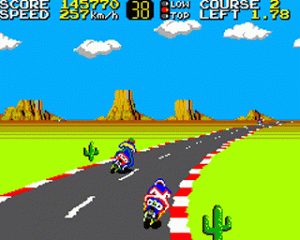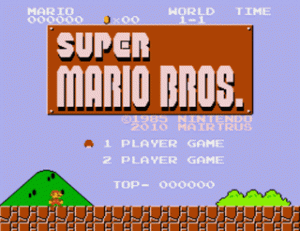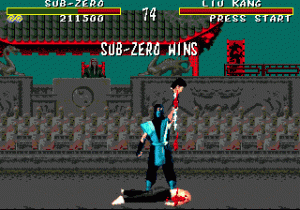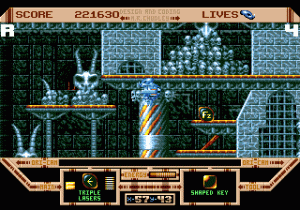As summer comes to a close and the leaves change color, some things stay the same. No matter what the season, there will always be plenty of Sega goodness to enjoy, and we’ve put together a selection of games we’ve been enjoying this month that is sure to get you playing!
Hang-On by Ken Horowitz
 As one of the two pack-in titles that came with my launch Master System (the other being Safari Hunt), Hang-On kept me busy for some time. It seems a bit bare bones now, but back then I found it quite addicting. My console came with those nifty little screw-on joysticks for the control pad, and I played better with them than without. I came away from those first few days with Hang-On feeling that it was a lot more fun than I expected it to be! It had taken me a bit of time to get the “hang” of the gameplay, given my natural inclination to try and outrace the other cyclists, but once I realized that all that mattered was the clock, I really began to enjoy Hang-On’s simplicity. The lack of music wasn’t a problem – a steady diet of Phil Collins and The Police filled the silence – since the gameplay was smooth enough that I didn’t really notice.
As one of the two pack-in titles that came with my launch Master System (the other being Safari Hunt), Hang-On kept me busy for some time. It seems a bit bare bones now, but back then I found it quite addicting. My console came with those nifty little screw-on joysticks for the control pad, and I played better with them than without. I came away from those first few days with Hang-On feeling that it was a lot more fun than I expected it to be! It had taken me a bit of time to get the “hang” of the gameplay, given my natural inclination to try and outrace the other cyclists, but once I realized that all that mattered was the clock, I really began to enjoy Hang-On’s simplicity. The lack of music wasn’t a problem – a steady diet of Phil Collins and The Police filled the silence – since the gameplay was smooth enough that I didn’t really notice.
Playing it again, the feeling remains, though I do admit that the sparse presentation stands out more now. I no longer have those joysticks (a modded three-button Genesis pad is my go-to controller now), but the gameplay holds up nicely. Sega had to really downgrade the game to fit on the Master System, but the essence remained intact. Hang-On is just a fun little title to play, despite how basic it is. That was likely the intention in packing it in with the machine, and it was indeed a wise one.
Super Mario Bros. (2010, by Mairtrus) by James Villone
I’ve been revisiting NES Super Mario Bros. that was ported accurately to Genesis in 2010. Back in the mid-’80s, this was the first video game I ever saw someone play at home, and I was amazed just at the fact that he could control the images on his TV! Mario 1 might actually be the single most nostalgic video game for me. The most impressive thing about SMB might be its universal appeal, starting out easy enough that small kids can enjoy the first stages. And experienced players can always try to speed-run the whole game, without dying or taking damage, which remains a healthy challenge, for anyone.
 The Genesis version was created with a program that automatically translated the NES game to Genesis with slightly-altered colors and music. The result is that the content is the same, but most of the colors have gotten brighter. The music also has a deeper hum.
The Genesis version was created with a program that automatically translated the NES game to Genesis with slightly-altered colors and music. The result is that the content is the same, but most of the colors have gotten brighter. The music also has a deeper hum.
I know the Internet age has brought a lot of speed-running for SMB, so I wanted to see how I might do at that on the Genesis port? The answer is: Lame! I’ve never completely gotten a handle on the controls, which are less fluid than subsequent platformers, even in the same 8-bit series (especially Mario 3). So, attempting a speed-run seems like an exercise in frustration.
Occasionally, I’ll find myself taking damage when jumping over an enemy, for example, from jumping too close or taking damage when trying to jump onto an enemy because of landing too far on the side of the enemy instead of directly on top. And occasionally, I’ll get stuck running for a moment, so I end up running off an edge that I meant to run-and-then-jump from. I believe these are the same quirks of the controls that I grew up with on NES, and it’s almost impossible to imagine anyone really mastering the controls completely.
I wonder if even the best speed-runners of SMB still struggle a bit, once in a while, with the controls? I bet they do.
Mortal Kombat by Ryan Sullivan
September 13th marked 25 years since Mortal Monday. Nintendo and Sega’s 16-bit and handheld systems got their own ports of Mortal Kombat on that day. I’ve never been a huge fighting game fan, but it is a series I have played at times when I was kid despite not owning any until 2005 with the SNES port of the first. It is quite easy to forget how big of a deal it was both in success and the controversy surrounding it. If you were to tell me what version to get out of the bunch, I would say this version on the Genesis, not because it has the blood, though that is a valid reason for arcade purists.
 Probe developed the Genesis version of Mortal Kombat and I’ll say this: It plays a lot smoother than the SNES version. The controls aren’t as sluggish and it’s simple, precise, and to the point. Pulling off some of the special moves feels very satisfying. Obviously, the graphics take a hit because of the stiff animations and the color palette. That can also be said for the sound, but the music is fantastic. One other thing is that this port is a little more accurate to the arcade with the screens, minus the little movie animations for each character and their bio.
Probe developed the Genesis version of Mortal Kombat and I’ll say this: It plays a lot smoother than the SNES version. The controls aren’t as sluggish and it’s simple, precise, and to the point. Pulling off some of the special moves feels very satisfying. Obviously, the graphics take a hit because of the stiff animations and the color palette. That can also be said for the sound, but the music is fantastic. One other thing is that this port is a little more accurate to the arcade with the screens, minus the little movie animations for each character and their bio.
This was one of those games I have revisited recently that does hold up a little bit. It’s not everyone’s cup of tea. There is a little bit of difficulty even on the easiest setting. Playing with the six-button controller works without any issues. It might be a simple game now these days, but that’s what makes some of these games from the ’90s timeless. The first Mortal Kombat is not a must buy, but it is one that you can get some good enjoyment even with the sequels.
Fatal Rewind by Goldenband
Here’s a question: is Fatal Rewind the hardest game on the Genesis, as more than one person has claimed?
Depends on how you define “hard,” I suppose, not to mention “on the Genesis”. Do we include the unlicensed Whac-A-Critter, a game widely thought impossible for humans to beat, in the mix? Or is there some pirate jank lurking out there that — like Bi! Bi! on the Atari 2600 — is literally impossible for anyone to beat thanks to programming errors?
 Anyway, “hard” can mean a lot of things: a test of reflexes, of memorization, of one’s willingness to endure the sadism of a non-cooperative RNG. In the case of Fatal Rewind, we’re mostly talking about the second kind of hard, since even the most perfect reflexes won’t get you past the third or fourth stage on your first playthrough. Even if you nail every enemy on sight without taking a hit, you’ll inevitably get lost in the game’s bizarre, wraparound levels and drown in a pool of D.O.L.L.
Anyway, “hard” can mean a lot of things: a test of reflexes, of memorization, of one’s willingness to endure the sadism of a non-cooperative RNG. In the case of Fatal Rewind, we’re mostly talking about the second kind of hard, since even the most perfect reflexes won’t get you past the third or fourth stage on your first playthrough. Even if you nail every enemy on sight without taking a hit, you’ll inevitably get lost in the game’s bizarre, wraparound levels and drown in a pool of D.O.L.L.
Honestly, Fatal Rewind doesn’t even demand that much in the way of twitch skills. In reality, the challenge is mental: it’s all about grasping the layout of each stage. Once you know the sequence of events necessary to get each key to its appropriate lock — without getting machine-gunned by a hidden skeleton gangster or swallowed up by the rising tide — you’re pretty much golden. If you get a hold of the Japanese version, which offers an Easy mode with unlimited continues, then you can learn each level without having to waste time replaying the ones you already know.
So, after hours of practice, I completed Fatal Rewind this past weekend — pulled off a 1CC, even. Did I beat the hardest game on the Genesis? Definitely not. Once I had a plan for every level, executing that plan was almost trivial, even if I messed up on occasion. That’s the weird thing about mastering a hard game: when you finally beat it, sometimes it’s anti-climactic, because you’ve already solved its problems well before you cross the finish line. Fatal Rewind is like that: punishing, but punishable.
Wait, did I say “solved”? Well, don’t let me get too smug, since I was playing on the default Normal difficulty, where the game has a nice flow and enemies never do too much harm unless you get sloppy. Try the game on Hard or Hardest, where enemies do double damage and you do the opposite, and suddenly Fatal Rewind has you over its knee again, spanking you for your temerity. And let’s not even discuss the Amiga version, which has two extra levels of torture to offer…

Recent Comments